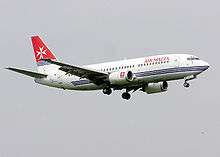Philippine Airlines Flight 143
 A Boeing 737-300 similar to the one involved, in Air Malta livery. | |
| Accident summary | |
|---|---|
| Date | May 11, 1990 |
| Summary | Fuel tank explosion while on ground |
| Site |
Manila Ninoy Aquino International Airport, Manila, Philippines 14°30′31″N 121°01′10″E / 14.50861°N 121.01944°E |
| Passengers | 114[1] |
| Crew | 6 |
| Fatalities | 8 |
| Survivors | 112 |
| Aircraft type | Boeing 737-300 |
| Aircraft name | PR143 |
| Operator | Philippine Airlines |
| Registration | EI-BZG |
| Flight origin | Manila Ninoy Aquino International Airport, Manila, Philippines |
| Destination | Iloilo Mandurriao Airport, Iloilo City |
Philippine Airlines Flight 143 (PR143) was a domestic flight from the Manila Ninoy Aquino Airport, Manila, Philippines to Mandurriao Airport, Iloilo City. On May 11, 1990, at Manila Ninoy Aquino International Airport the Boeing 737-300 (C/N 24466, MSN 1771) assigned to the route suffered an explosion in the central fuel tank and was consumed by fire in as little as four minutes.[2][3]
Accident
The air temperature had been high at the time of the accident, about 35 °C (95 °F), while the Boeing 737-300 was parked at Manila. The air conditioning packs, located beneath the center wing fuel tank of the 737 had been running on the ground before pushback (approximately 30 to 45 minutes). The center wing fuel tank, which had not been filled since March 9, 1990, likely contained some fuel vapors. Shortly after pushback a powerful explosion in the center fuel tank pushed the cabin floor violently upwards. The wing tanks ruptured, causing the airplane to burst into flames.
The majority of the 113 passengers and 6 crew were able to escape via the emergency chutes, which had been deployed following the blast.[2]
Several passengers reported as many as three explosions in the plane, and Oscar Alejandro, then director of the Philippine Air Transport Office, confirmed the engines had not been started at the time of the blasts.[2]
It is thought the vapors ignited due to damaged wiring, as no bomb, incendiary device or detonator had been found at the scene.[1] The airline had fitted logo lights after delivery which required passing additional wires through the vapor seals in the fuel tanks. The NTSB recommended to the FAA that an Airworthiness Directive be issued requiring inspections of the fuel boost pumps, float switch and wiring looms as signs of chafing had been found. The FAA declined to issue the Airworthiness Directive.[4]
Casualties
There were 8 fatalities among the 120 on-board passengers and crew from the violent explosion on the ground at Manila Ninoy Aquino International Airport.
Among the fatalities were six adults and one child, while another 82 people were treated for smoke inhalation and other injuries at the airport clinic. There were no ground fatalities or injuries from the explosion.[1][5]
References
- 1 2 3 Accident description at the Aviation Safety Network
- 1 2 3 "Filipino jet explodes on takeoff, 8 killed". Pittsburgh Post-Gazette. Associated Press. 12 May 1990. Retrieved 26 May 2013.
- ↑ Goglia, John (27 January 2011). "FAA finally takes action on fuel inerting". Aviation International News. Retrieved 27 May 2013.
- ↑ 737 accident reports
- ↑ Cortes, Claro (11 May 1990). "Seven die in plane blast". The Free Lance-Star. Retrieved 26 May 2013.